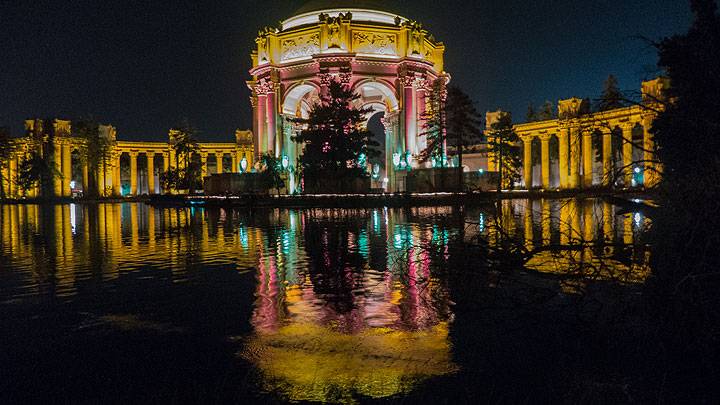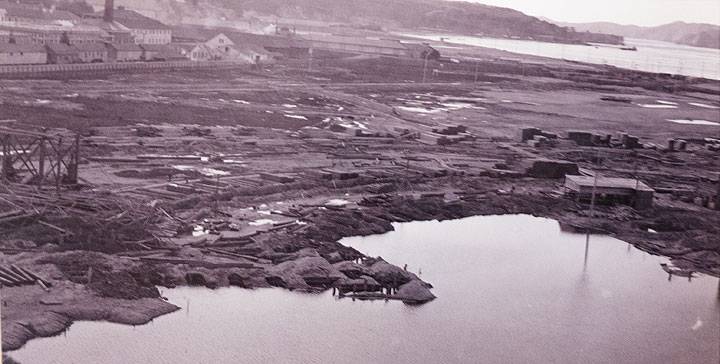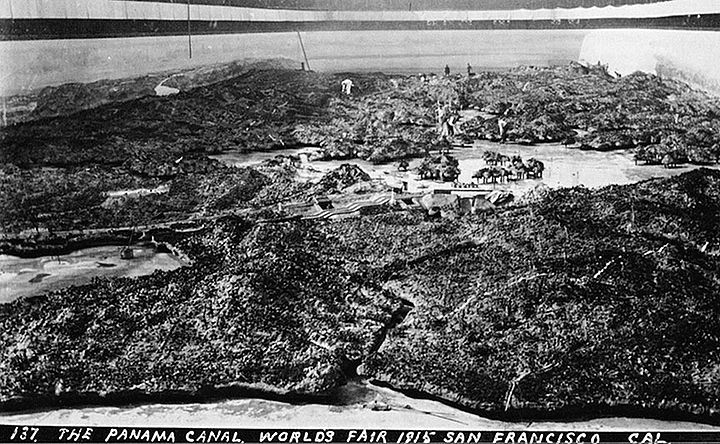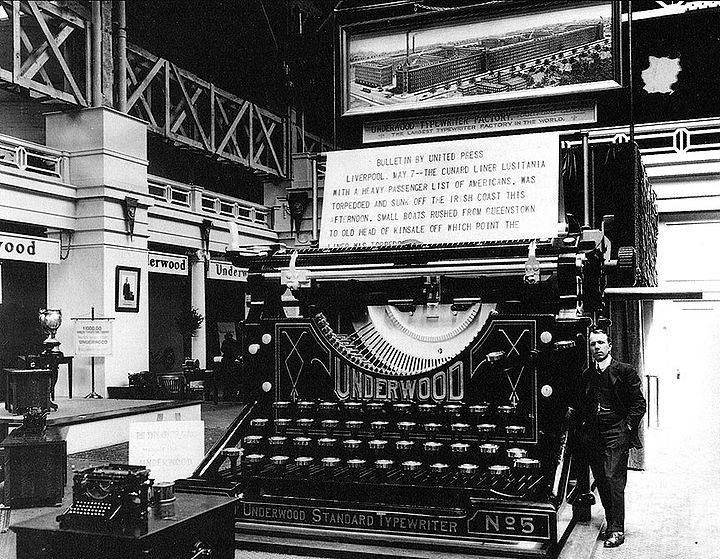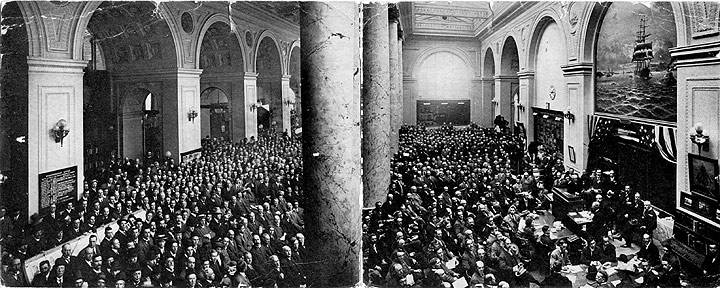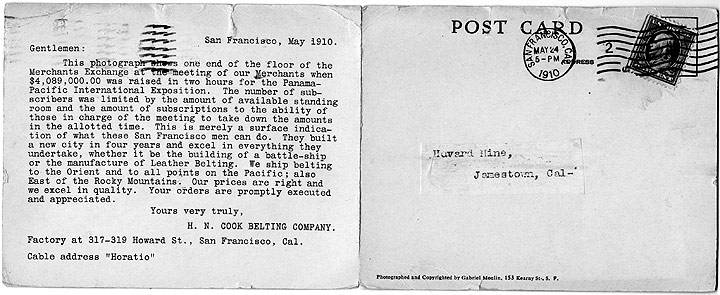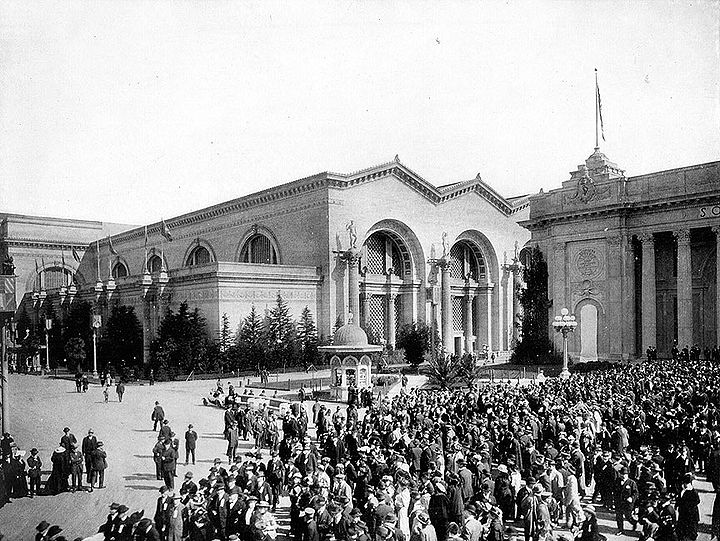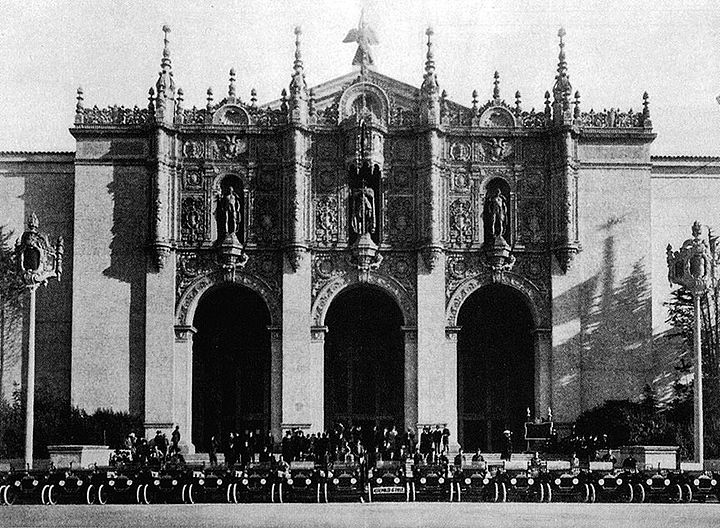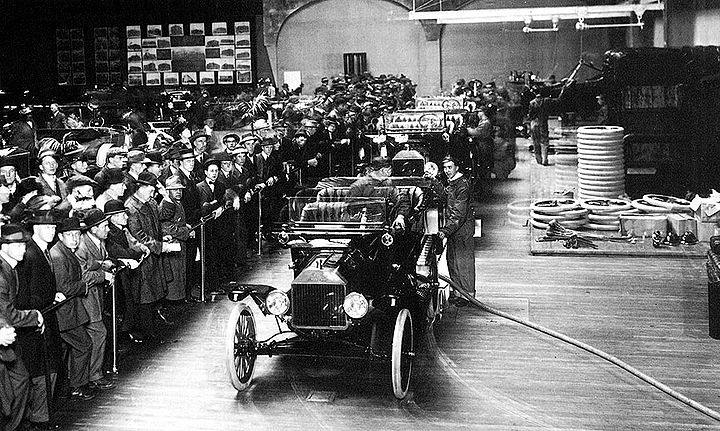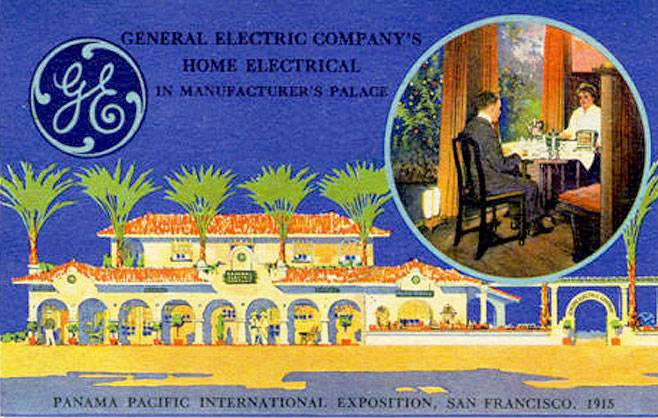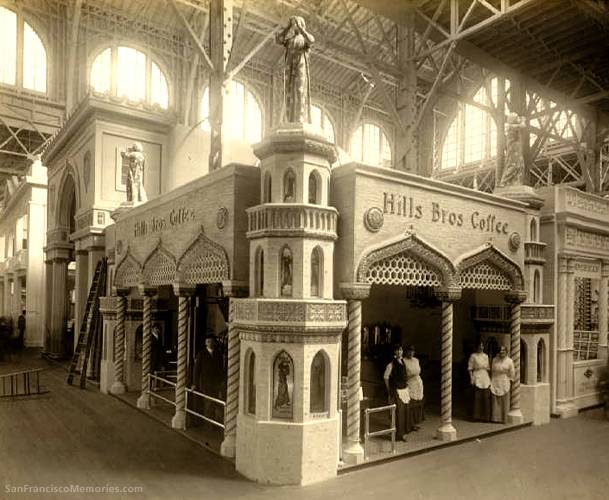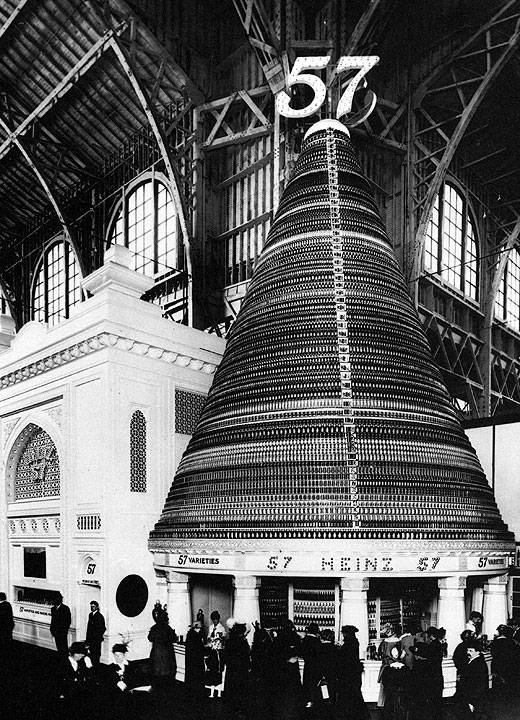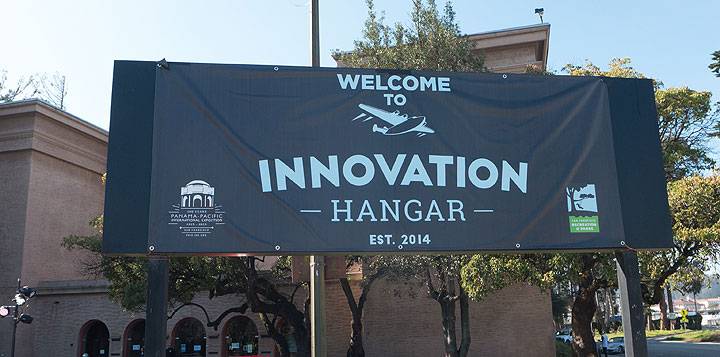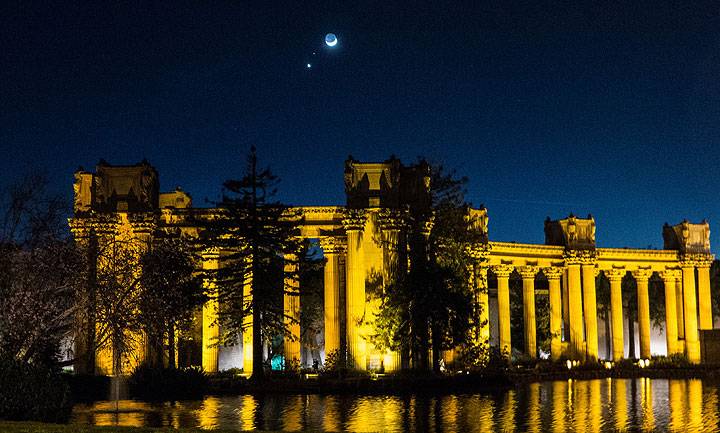PPIE: A Festival of Empire Wrapped in Technological Hubris
Historical Essay
by Chris Carlsson
| The Panama-Pacific International Exposition (PPIE) took place 100 years ago in San Francisco. It officially commemorated two major events: the opening of the Panama Canal and the rebuilding of San Francisco after the 1906 earthquake and fire. Now San Francisco is celebrating the centennial with parties and discussions and art shows, all nurturing a nostalgic ardor for the long-forgotten Fair, its short-lived but stunning fair grounds, and less consciously, a yearning for the certainties of that bygone era. |
The famous Bernard Maybeck-designed Palace of Fine Arts lit up according to the original scheme on the centenary of the Panama-Pacific International Exposition, Feb. 21, 2015.
Photo: Chris Carlsson
Like all World’s Fairs during the pre-WWI era, it was an extravaganza of technological and industrial innovations, fueling desires and shaping imaginations. Before multimillion dollar advertising budgets, World’s Fairs gave businesses their best chance to present their wares to a broad, often international audience. The PPIE benefited from the concentration of so many products and manufacturers, helping to stimulate a lively convention business in San Francisco during its run. As Laura Ackley’s fine overview of the Fair (San Francisco’s Jewel City) emphasizes:
The exhibits reflected the Fair’s dual goals: to serve as “University of the World” and “Shop-Window of Civilization.” … A week at the Exposition “will give you a view of the World’s Progress that could not be obtained in a Year of Travel,” proclaimed a pamphlet marketing conventions at the Fair… More than 900 congresses and conferences were held during the year, and were credited with boosting daily attendance from about 25,000 per day to more than 60,000 per day.
This was Harbor View before it was filled and graded to become home to the PPIE, and later to the upscale Marina District.
Photo: California Historical Society
Scale model of the Panama Canal at the Fair, 1915.
Photo: Chuck Banneck
The PPIE enthusiastically celebrated the promise of accelerated and expanded global trade facilitated by the opening of the Panama Canal, even while WWI raged across Europe and the Atlantic Ocean. The European world system, dominated by England, France, and Germany, went to war despite the massive socialist working-class movements in each country. Internationalist and socialist workers who opposed national frontiers and nationalist wars on principle nevertheless voted in their respective parliaments for the war credits that paid for the barbarism that ensued.
The United States was determined to stay out of the war and during 1915 President Woodrow Wilson maintained a non-interventionist foreign policy. His Secretary of State William Jennings Bryan, committed to avoiding war, resigned in June when Wilson sent a letter of reproach to Germany’s Kaiser Wilhelm after German u-boats sank the Lusitania in 1915. Two weeks after Bryan gave a speech at PPIE on July 5 calling for peace, former president Teddy Roosevelt came through to exhort the belligerent inclinations of the population and to demand “preparedness,” the code word then for war.
San Francisco had large immigrant populations of German, Irish, Italian, and Chinese. The city was divided between those with sympathies toward the British and French side, or the Germans on the other, but after the sinking of the Lusitania, most Americans turned against the Germans. Meanwhile, General Pershing was in Texas preparing to lead an army into Mexico in pursuit of Pancho Villa and his revolutionary troops in 1916, before he would lead U.S. forces into WWI in 1917. Other U.S. soldiers were still engaged in hostilities in the Philippines, seventeen years after the United States had fraudulently annexed that country under the cover of the Spanish-American war. The Presidio—adjacent to the PPIE grounds—was an important military base housing thousands of soldiers coming and going from these wars. Isolationism still had political support from many, but realistically, the U.S. was well on its long path to global superpower status.
Before computers... but it's the keyboard we still have! ... 21-foot wide 14-ton Underwood Typewriter striking a 9-foot wide sheet of paper.
Photo: Shaping San Francisco
The PPIE helped showcase new developments which came to underpin the U.S. war machine in following decades (from Ackley’s Jewel City):
… a grim portent of the Great War (WWI) was on display. The Holt Manufacturing Company of California displayed a train of Holt Caterpillar trucks drawn by a Caterpillar tractor featuring the first commercially successful continuous track, the forerunner of modern tank treads. In 1915 six European armies were using these vehicles for military transportation, and by the following year Holt machines were being sold to the Allied Forces and refitted as true armored tanks.
Adventurous citizens could take airplane rides at the Exposition, as brother Malcolm and Allan Loughead ran a charter hydro-aeroplane service, offering ten-minute flights for $10. Each flight passed over the Presidio to Fort Point, up the Marin Headlands, and back over Sausalito and Alcatraz before landing in the water and taxiing up a wooden ramp. This was the first airplane ride for nearly every customer, made all the more hair-raising because the blue of the bay could be seen through the floorboards of the homemade craft.
The PPIE marked a turning point for the Loughead brothers. The… early charter flights failed to make money. After paying Exposition concession fees the brothers made a $4,000 profit, money they used to found what would become—after a spelling change—the Lockheed Aircraft Corporation.
Postcards courtesy of Barbara Webster collection
During the years-long planning and construction process, local businessmen dominated the preparations and controlled the event, keeping corporate enterprise in the driver’s seat. Already the ideology of “growth” dominated the political visions of businessmen and citizens across the political spectrum. Organized labor, so strong during the first decade of the 20th century, had seen its power diminishing since the election of “Sunny Jim” Rolph, displacing the Union Labor Party from the mayor’s office for good. AFL unions, especially those organized under the Building Trades Council, were nervous about asserting themselves too aggressively, a stance that suited Fair managers just fine. In fact, tens of thousands of unskilled workers had poured into San Francisco between 1911 and 1914 seeking work building the Fair, threatening to undercut the wages and standards established by the unions.
Michael Kazin’s excellent Barons of Labor recounts the history of the Building Trades Council during those early decades of the 20th century. Here he reports on the situation facing skilled workers as the Fair took shape:
In the winter of 1911-1912 and again in 1913-1914, migrants who came to town seeking a job on the exposition and/or a haven from the seasonal rains formed a frustrated, incipiently rebellious mass. Thousands of ill-dressed demonstrators marched down Market Street, lined up to get food and bedding from a union-sponsored League for the Protection of the Unemployed, and heard labor leaders and city administrators plead with them to leave San Francisco. For the first time in the long history of seasonal joblessness on the West Coast, marchers, apparently inspired by IWW organizers, demanded public employment at union wages—“not as a charity, but as a right.” Free meals and floor space in a municipal flophouse did not pacify the transient army which, in the early months of 1914, grew to perhaps 30,000. With this unhappy throng at their backs, most building unionists understandably restrained their own demands in the interest of job preservation… By 1915, despite the impetus of the exposition, the number of Building Trades Council dues-payers had shrunk to less than half the total during the hectic days following the earthquake and fire.
The Aeroscope, San Francisco's answer to the Eiffel Tower and the Ferris Wheel, designed by Joseph P. Strauss, who later designed the Golden Gate Bridge
Photo: Scientific American, 1915
The Race Betterment Society Booth at the PPIE—The World's Fair basked in the glow of scientific rationalism and was a key meeting place for the early eugenicist movement, a blatantly racist expression of so-called scientific rationalism at the time, but one that continued to influence California and U.S. politics for decades. It wasn't discredited until one its most avid adherents, Adolph Hitler and his German Nazi Party, put its precepts into action in what we now call the Holocaust.
Photo: Shaping San Francisco
Meanwhile, for folks across the class spectrum, everyday life in the U.S. was changing faster than ever, an intensification and acceleration that had been jump-started during the post-Civil War decades of rapid industrialization. In an outstanding new book by Gary Cross and Robert Proctor called Packaged Pleasures: How Technology & Marketing Revolutionized Desire, the authors closely examine the way daily life was radically altered by the industrialization and commodification of sensations, pleasures, and tastes that had historically been relatively rare. They show how the mass production of cigarettes, candy bars, and soda pops, and their sudden easy availability, changed people’s lives socially and biologically:
…packaged pleasures have often de-socialized pleasure taking. Many create neurological responses similar to those of religious ecstasies, physical exercise, and social or even sexual intercourse, and can end up substituting for, or displacing, such enjoyments. [Candy bars, e.g.] …are now very often eaten alone, while driving, for example, or between meals as a quick fix to save on time that would be lost sharing a meal with others. Available virtually any hour of the day at many types of stores and vending machines, these ready-to-eat foods led to the modern habit of grazing, contributing to obesity and the decline of the sociable “breaking of bread” at meals.
The 1915 PPIE was many things to many people, but at every turn it was a festival of advertising. Before commercial radio became ubiquitous in the mid-1920s, and long before television, World’s Fairs were a focus of state-of-the-art products and marketing. More than 80,000 exhibitors, especially large corporations, spent vast sums on elaborate pavilions, booths, and displays. We can perhaps forgive San Franciscans of 1915 for their gape-jawed enthusiasm for the modern marvels on display at the PPIE. The millions who thronged the PPIE during its 9-month life on the northern shore of San Francisco were immersed—many for the first time in their lives—in a cornucopia of alluring products all promising a better life. But most people were already accustomed to the worldview that helped make the PPIE a popular success. San Francisco came of age with the emergence of photography, a key technology in establishing popular comfort and enthusiasm for technological innovation. As Cross and Proctor note,
Photography taught mid-nineteenth-century moderns to embrace a positive attitude toward rapid technological change. The photo, produced by advances in chemistry and optics, was magical and liberating. It did not threaten a way of life (except perhaps for a few painters). Some even claimed that the photograph enhanced individuality, allowing consumers to portray themselves personally and quasi-permanently to others.
Crowds throng outside the Palace of Machinery. There were machines of precision and power for transportation, construction, agriculture, mining, and home use. Wherever possible, machines were shown in operation, and often in cross-section or cutaway views.
Photo: Shaping San Francisco
Few exhibits were as popular at the PPIE as the operational Ford Model T assembly line inside the Palace of Transportation. Eighteen cars a day began rolling off the line on the first day of the fair, about one every ten minutes for the 3-hour shift. There was already a Ford Motor Company factory at 21st and Harrison in the Mission making Model T’s, but the Fair’s emphasis on making it easy to see how things work brought daily crowds to watch the line.
Just ten years earlier there had been only 77,400 cars in all of California. In 1915 California’s first paved highway connected the PPIE to the other World’s Fair in San Diego, but by then there 2.3 million cars rolling around, mostly on dirt roads in California. Ten years later, building on the enthusiasm for private cars that the PPIE contributed to, there were 17.5 million passenger autos on California’s expanding system of streets and highways.
At the dawn of the automobile era, it is perhaps understandable how excited everyone was to embrace the new, highly personalized form of what appeared then to be relatively efficient transportation. But 100 years later, we’re still ogling and selling and buying cars, even though we know what car culture has done to our lives, to California’s landscapes, to the configuration of urban and suburban space.
18 Model Ts were produced every day on the state-of-the-art assembly line at the Fair. Here is one day's production parked outside the Palace of Transportation.
Photo: Ford Times, 1915
The Ford Assembly line at the PPIE, 1915. 4,400 cars were made during the 9 months of the Fair.
Photo: Shaping San Francisco
General Electric went all in during the PPIE to promote its new appliance line, long before most U.S. homes had electricity! PG&E had been put together in 1905 to sell electricity to the whole of northern California. As the PPIE opened, their expansion of hydropower through damming the state’s rivers was well underway. From Laura Ackley's San Francisco's Jewel City:
Inside a full-sized house, a tidy Mission-style bungalow, General Electric presented the latest in home conveniences operated by electricity. Even though only approximately 10% of American homes were electrified, GE promoted its wares with a view to the future. The company took care to state that the purpose of this Home Electrical was not to amaze or astonish but to present practical applications to “reduce the drudgery of housework” for anyone of “moderate means.”
Appliances in the Home Electrical included an electric fireplace, an intercom, a player piano, fans, a toaster, a coffee maker, a sewing machine, a clothes washer, and ironing machines… Many of the electrical appliances are still common, but their 1915 versions were immense compared to current compact models. The refrigerator was predictably located in the kitchen, but its attendant plumbing and “motor-driven ammonia compression tanks” were in any adjoining room, and the “stationary vacuum unit” took up most of one wall in the utility shed…. One amenity showcased in the garage: the electric car charging station.
This dazzling technological promise to eliminate the drudgery of household chores of course has never really come to fruition. As machines augmented capacities to clean, standards of cleanliness steadily rose too. Housework in 2015 is still an imbalanced burden falling largely on women whether or not they are wage-workers as well. But behind the allure of technological “fixes” lie deeper assumptions that are so firmly embedded in the structure of our lives that we rarely pause to question them. Langdon Winner’s 1986 book The Whale and The Reactor takes this on directly:
By the late 19th century, an impressive array of scientific discoveries, technical inventions, and industrial innovations seemed to make the mastery of nature an accomplished fact rather than an idle dream. Many took this as a sign that all ancient wisdom, like all the old-fashioned machines and techniques, had simply been rendered obsolete…. According to this view, everything one might desire of the relationship between expanding industrial technology and the building of a good society will happen automatically. All that is necessary is make sure the machinery is up to date, well maintained, and well oiled. The only truly urgent questions that remain are ones of technical and economic efficiency. Individual habits, perceptions, concepts of self, ideas of space and time, social relationships, and moral and political boundaries have all been powerfully restructured in the course of modern technological development. What is fascinating about this process is that societies involved in it have quickly altered some of the fundamental terms of human life without appearing to do so. Vast transformations in the structure of our common world have been undertaken with little attention to what those alterations mean. Judgments about technology have been made on narrow grounds, paying attention to such matters as whether a new device serves a particular need, performs more efficiently than its predecessor, makes a profit or provides a convenient service. Only later does the broader significance of the choice become clear, typically as a series of surprising “side effects” or “secondary consequences.” But it seems characteristic of our culture’s involvement with technology that we are seldom inclined to examine, discuss, or judge pending innovations with broad, keen awareness of what those changes mean.
This deep transformation of life through technological redesign has induced a kind of willful blindness in most people. Few think to ask why? Why should we adopt a particular technology? Why should we do a certain type of work? Why should a type of work—which is some combination of human endeavor, machinery (technology), and nature—be organized the way it is? This dissociation is the ticking heart of Liberal capitalism. We can see that our much-touted “democracy” doesn’t really provide an avenue to discuss or evaluate the technological direction of society. With the exception of an occasional referendum on nuclear power or genetically modified foods, average citizens are rarely allowed to participate in evaluating or deciding what purpose work and technology should serve, or how a given possibility might help or hurt such socially chosen goals.
In spite of the lack of formal democracy regarding the technological infrastructure, in the past half century San Franciscans have put up some real resistance to the inexorable path laid out by modernists, politicians, and other experts. Thus, the Freeway Revolt put a halt to the crisscrossing of the City by massive cement freeways in the mid-1960s. The “Save the Bay” movement succeeded in putting strict controls on filling the bay’s shallow waters, and within another five years, the major environmental legislation of the U.S. was becoming law, in particular the Clean Water and Clean Air Acts. By the early 1970s, the organics revolution was taking root thanks to radicals, hippies, and farmworkers who had put up a vigorous fight over the use of DDT on California grapes, and had in some cases gone back to the land to start organic farming. Still others had pioneered “food conspiracies” and food co-ops that confronted the edifice of supermarkets, corporate agribusiness, and the oil industry, and developed a food politics that contested many of the assumptions that were the foundation of their power.
Back in 1915, in the Palace of Foods, humorously nicknamed “Palace of Nibbling Arts,” corporate food purveyors set up elaborate displays to sell the idea that food untouched by human hands was the best, most modern way to feed your family. It took many years before the tide began to turn back towards whole, natural foods, untouched by chemicals, often unpackaged by plastics, and sold for their health, nutritional content, and flavor. During the 1915 PPIE the problems of tainted food that had been dramatically revealed by Upton Sinclair’s novel “The Jungle” were being addressed by the Federal Government’s early efforts at food regulation. Corporations such as Sperry Flour, Heinz condiments, and Carnation milk all promised the healthiest and safest foods, guaranteed by their mechanized processing systems and airtight packaging in sealed tin cans. (Concurrent with the PPIE was the development of crimping for sealing cans, which finally allowed canned food manufacturers to ship their products without actual bits of lead inside the can!)
Hills Brothers coffee exhibit, PPIE 1915.
Photo: SanFranciscoMemories.com
Heinz selling a pyramid of condiments...
Photo: Shaping San Francisco
The PPIE itself was a “packaged pleasure” of the sort analyzed by Cross and Proctor.
the amusement park was a site, a confined space. It captured a multiplicity of sensations, becoming a kind of sensorial emporium… world’s fairs were “showplaces of ever-changing commodity culture,” offering “training grounds for a disposable visual culture.” Fairs taught audiences the “protocols of modern spectating” and created easily copied thrills that entrepreneurs would soon exploit commercially, especially in amusement parks.
Contributing to the sense of the new that met visitors at every turn was the placing of films in many of the exhibitions. Early movies gave viewers a chance to see things they had never seen before. Cross and Proctor emphasize the importance of cinema at teaching consumers to see differently. Laura Ackley describes:
Once the PPIE opened, states and nations showed films extolling their unique virtues, beauty, and prosperity in small theaters located in their pavilions. All through the main palaces, displays were augmented with movies, though in this pre-talkie era, most of the instructive films were accompanied by live narrators.
In the PPIE a century ago we can see the beginning of the culture of watching that is now so taken for granted that many U.S. homes have the television on 8-14 hours a day. The society of the spectacle was fully analyzed by the Situationists and countless interventionists since the 1950s who have used the images and symbols of mass media to invert messages and to try to subvert the dominant paradigms. In 2015 though, we can go to the so-called “Innovation Hangar” at the Palace of Fine Arts, one of the showpieces of this year’s centennial celebrations. In it you will find the usual mishmash of trivial technology projects all claiming to be “innovative.” But computer games meant to facilitate playing and escape are hardly a new idea. Nor are virtual reality headsets, and neither is an app to help you find parking. Mostly they seem to be selling the idea of escape and avoidance of the messy realities of daily life in the city. Hardly an innovative bone in their aluminum bodies.
The so-called "Innovation Hangar," re-dubbed "The Palace of Neoliberalism" by some, in the old Exploratorium site, 2015, to celebrate the centennial of the PPIE.
Photo: Chris Carlsson
One hundred years after the PPIE, official San Francisco uncritically embraces the techno-utopianism and imperial hubris of a century ago. We have spent months enjoying endless mild summer weather during the fourth year of extreme drought, knowing the east is frozen solid and knowing that chaotic weather is the new norm. Most of us know it will get worse, given our unwavering commitment to burning fossil fuels.
Innovation and development, the buzzwords in the Palace of Neoliberalism, do not even address this fundamental problem. Instead, narrow projects pursuing greater efficiency, so-called smart data, and ever more intrusive systems of surveillance, alongside frivolous pursuits of gaming, virtual reality, and escape, and the absurdity of “fixing” the glut of private cars by technologizing the search for a parking place—these are what our imagination-starved, colonized technicians come up with as “innovative.”
In today’s San Francisco, entrepreneurialism is a kind of civic religion. The self-declared “start-up” priests all sing the same hymn: some kind of new product will change the world, will solve social crises, solve ecological crises, give us back a genuine sense of community, restore civility and neighborliness… It’s always about a device, a technology, a new system, and never about rethinking how humans relate to each other and their political lives. Certainly no innovators are discussing the idea that decisions about the direction of economic life, or how we carry out the “making of life” everyday should be subjected to new kinds of democratic norms.
The PPIE celebration might be a moment to think critically about history, and especially how that World’s Fair helped shape the world we’re still living in. But our culture’s relationship to history is weak at best. So far, the first weeks of the year-long commemoration has brought forth a civic wave of nostalgia for a past imagined through rose-tinted glasses, but not much critical reflection. The reigning logic of neoliberalism reproduces and reinforces the worst of that era—that private ownership and private initiative are—and should be—the dynamic forces in society. Unlike during the original PPIE, which took place under the interventionist state government of progressive Republican Hiram Johnson, today the government is widely discredited as a means to address the problems of society. But similar to the culture of a century ago, we still uncritically accept the idea that technological innovation and economic growth are reliable answers for every question.
A remarkable view of the Moon, Venus, and Mars over the Palace of Fine Arts on Feb. 21, 2015.
Photo: Chris Carlsson

